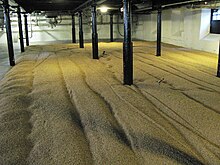Malting process
Appearance
The malting process converts raw grain into malt. The malt is mainly used for brewing or whisky making, but can also be used to make malt vinegar or malt extract. In a modern malt house the process is more automated.
Quotes
[edit]

- The maltster, never resting in winter.
- Silver, in Debate between Silver and Copper (middle to late 3rd millennium BCE). [1]
- Malting to a very great extent determines the character of the wort to be fermented, and the fermentation acts upon that wort badly or well, not only in direct relation to the quality and nature of the yeast added, and the conditions of temperature and other surrounding influences of the wort, but in a greater and more important manner according to the nature of that wort itself. The wort is not only the element surrounding the yeast-plant, but it is the food-supply also, and upon the character and quality of the food supplied, the development and well-being of the yeast-crop mainly depend. My own experience has taught me that kiln-drying and mashing exercise almost equally great influences upon the character of the wort, and as the one stage necessarily precedes the other, it must take the first place especially as the influences of the kiln are more permanent than those of the mash-tun.
- Henry Stopes, Malt and Malting, an Historical, Scientific, and Practical Treatise (1885) p. 361.
- To dry pale malt well three things are necessary:
1. It should be loaded... as sound green-malt upon a floor at the thickness rarely, if ever, exceeding seven to eight inches.
2. It must remain unturned at a low temperature until nearly all moisture is removed.
3. Heat must then be applied steadily and freely, and be maintained for a considerable time at a nearly uniform height ranging from 160° to as high as 230° in some cases.
With these three rules... vast quantities of malt now daily spoiled in the making, could be manufactured into a thoroughly sound and useful article.
A really well designed and good kiln can always ensure the following conditions.
Malt completely dried (i.e., deprived of 97 per cent of the total moisture present in green malt).
Uniformity of dryness, colour, flavour, and aroma.
Economy of working in cost of fuel consumed and labour employed.- Henry Stopes, Malt and Malting, an Historical, Scientific, and Practical Treatise (1885) pp. 361-362.
See also
[edit]External links
[edit]Wikibooks has a book on the topic of




